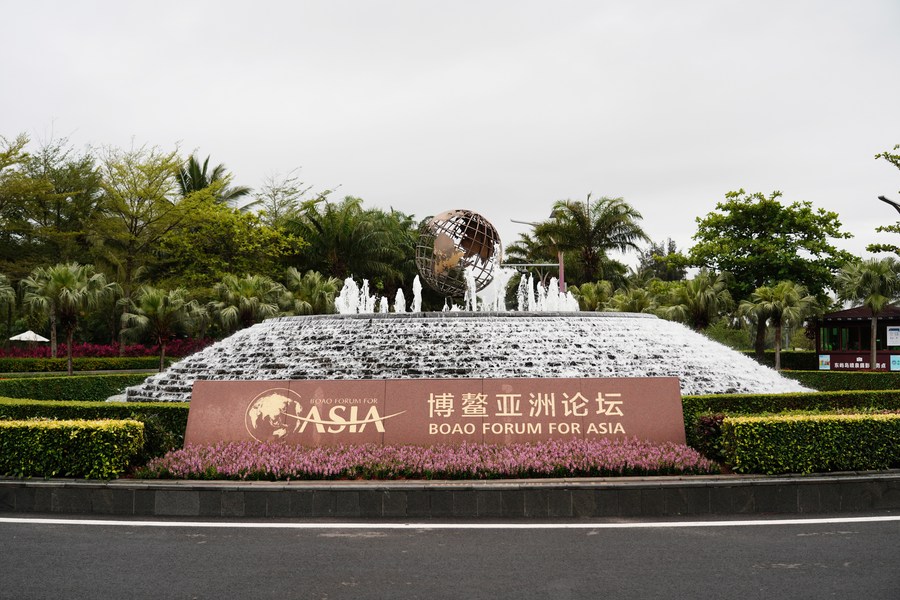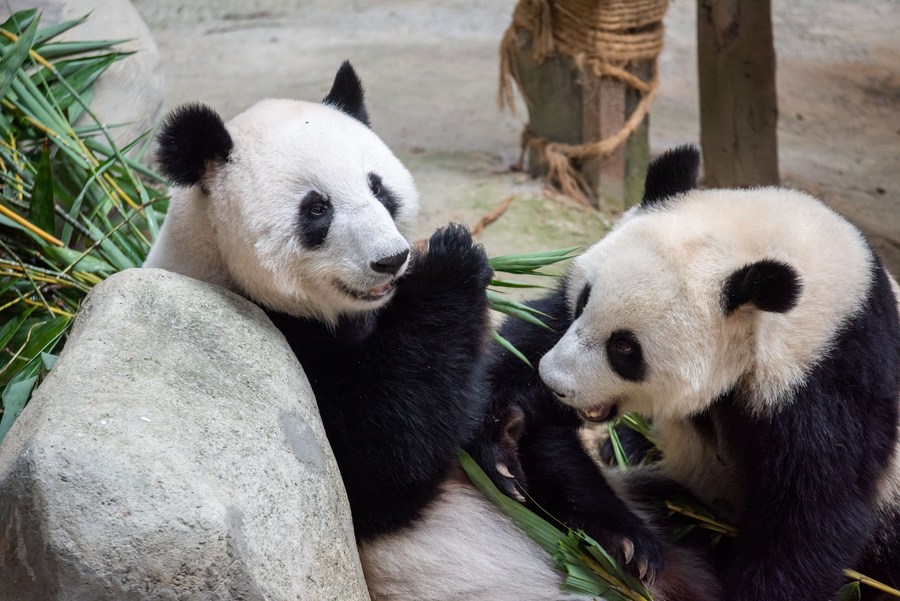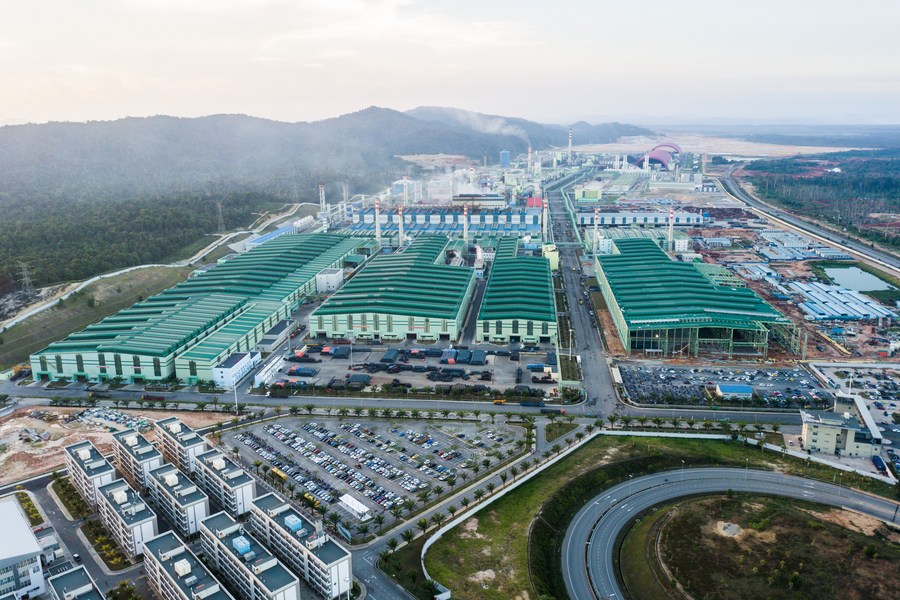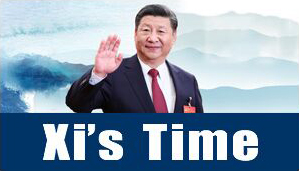
This photo taken on March 27, 2023 shows a fountain square in front of the Boao Forum for Asia (BFA) International Conference Center in Boao, south China's Hainan Province. (Xinhua/Fan Yuqing)
For years, China and Malaysia have worked closely to advance high-quality Belt and Road cooperation and made joint efforts to reach a consensus on building a China-Malaysia community with a shared future, so as to benefit the two peoples.
BEIJING, April 3 (Xinhua) -- At the invitation of the Chinese leadership, Malaysian Prime Minister Datuk Seri Anwar Ibrahim attended the Boao Forum for Asia Annual Conference 2023 and paid an official visit to China from March 29 to April 1.
It has been Anwar's first visit to China since he took office in November 2022. It is also an important visit to push forward bilateral cooperation on the occasion of the 10th anniversary of the China-Malaysia comprehensive strategic partnership.
China and Malaysia have a long-standing friendship, and next year will mark the 50th anniversary of the establishment of their diplomatic ties.
For years, the two sides have worked closely to advance high-quality Belt and Road cooperation and made joint efforts to reach a consensus on building a China-Malaysia community with a shared future, so as to benefit the two peoples.
BELT & ROAD COOPERATION
As one of the first countries to respond to the Belt and Road Initiative, Malaysia has since reaped a bumper harvest.
Chee Mun Yan, a 30-year-old Malaysian Chinese, has lately realized a dream. She took her mother to experience the MRT 2, the second Mass Rapid Transit line in Klang Valley, Malaysia.
Chee joined the China Railway Group Limited in Malaysia in 2016 upon graduation and is currently an environmental manager. For the past few years, she has worked with her colleagues on the construction of Bandar Malaysia North station, Bandar Malaysia South station, and related twin tunnels, key points along MRT 2, to manage any potential worksite pollution.

Chee Mun Yan (2nd L), an environmental manager of CREC, takes her mother (1st L) for a ride on MRT 2 in Kuala Lumpur, Malaysia, March 16, 2023. (Photo by Chong Voon Chung/Xinhua)
On March 16, MRT 2 started operation. On the first train launched, Chee walked through the crowd to the front compartment with her mother hand in hand, and explained to her mother the station projects she had participated in. Amid the praises for MRT 2 from passengers, Chee felt very proud.
Due to the Belt and Road Initiative, more and more Chinese enterprises are investing and doing business in Malaysia, which not only facilitates the upgrading of local infrastructure and directly benefits people's livelihood, but also brings advanced technology and management experience to the local people.
Brahim Bin Senik, head of a village in Dungun District, Terengganu State, has recently made frequent visits to a construction site near his village. The taller the bridge piers grow, the sooner his dream will come true.
"These bridge piers are built for the East Coast Rail Link (ECRL). After completion, the trains can travel directly across the Dungun River. We all look forward to this day coming soon," said the 59-year-old man, with joy in his eyes, showing a map that marks the ECRL line.
"Our village is only 2 km away from the station. I hope to travel to Kuala Lumpur with my villagers by this train," he said.
The ECRL, Malaysia's mega rail project with a total planning length of over 600 km, is being built by China Communications Construction Company. The rail link is expected to greatly enhance connectivity and bring more balanced growth to the country by linking its less-developed region on the east coast to the economic heartland on the west coast.
Malaysian Transport Minister Anthony Loke Siew Fook, who has made multiple visits to China, stressed repeatedly in an exclusive interview with Xinhua the significance of Belt and Road cooperation for Malaysia.
Loke said that Malaysia's transport industry, including important projects such as the ECRL and MRT 2, has renewed its vitality thanks to the participation of Chinese enterprises.
"The ECRL is a project of strategic significance. After completion, it will promote economic and industrial development along the eastern coast, and at the same time connect the east coast with Port Klang, Malaysia's main port," he said.
DEEPENING FRIENDSHIP
China and Malaysia have a long history of friendly exchanges. The story that Chinese navigator Zheng He from the Ming Dynasty and his fleet visited Malacca five times in his seven voyages is well-known in Malaysia and has become an exemplar in the history of China-Malaysia exchanges. Since establishing diplomatic relations in 1974, the two countries have been sharing weal and woe and forging ahead hand in hand.
In 2014, a giant panda couple named "Xing Xing" and "Liang Liang" came to Malaysia on the occasion of the 40th anniversary of diplomatic relations between the two countries.

Giant panda Liang Liang (L) and Sheng Yi eat bamboo leaves at Zoo Negara near Kuala Lumpur, Malaysia, March 11, 2023. (Photo by Chong Voon Chung/Xinhua)
Adored by the Malaysian public, the panda family has accustomed to eating bamboo produced in Malaysia and can understand a little local language. For Akmal and his colleagues, who spent nine years taking care of the pandas, they have already become one of their family members.
Besides China's national treasure the giant panda, Chinese culture, represented by the Chinese language and traditional Chinese medicine (TCM), is also gaining popularity among non-Chinese ethnic groups in Malaysia.
Just a few days ago, the second China-Malaysia Intervarsity Chinese Debate Competition concluded, and students from 26 well-known universities and colleges in China and Malaysia exchanged ideas and enhanced mutual understanding over debate topics in education, science and technology, ecology, and other fields.
In Chinese schools in Malaysia, non-Chinese students accounted for over 20 percent of the total. In a TCM diagnosis and treatment center in Kuala Lumpur, a Malay female physician Amiera said that more and more non-Chinese students are enrolled in TCM courses.
Since 2009, TCM education in Malaysia has gradually changed from privately-run education to government-approved higher education. There are now eight universities and colleges providing TCM courses taught in both Chinese and English.
NEW MOMENTUM FOR DEVELOPMENT
Located in the capital city Kuantan of Pahang state and launched in 2013, Malaysia-China Kuantan Industrial Park (MCKIP) is a key Belt and Road cooperation project and a demonstration base for cross-border industrial capacity cooperation. The MCKIP, together with the China-Malaysia Qinzhou Industrial Park situated in China, has set an innovative example of bilateral economic cooperation under the model of "Two Countries, Twin Parks."

Aerial photo taken on April 15, 2019 shows the Alliance Steel at the Malaysia-China Kuantan Industrial Park in Pahang, Malaysia. (Xinhua/Zhu Wei)
For the past decade, President Xi Jinping has been following the construction and development of the twin industrial parks. When meeting with Anwar in Beijing on Friday, Xi called on the two sides to continue to raise the level of high-quality Belt and Road cooperation, advance key projects, foster growth areas in the digital economy, green development and new energy, and explore cooperation on people's livelihoods so that China-Malaysia relations will bring more benefits to the two peoples.
Lu Yong, executive deputy general manager of Beibu Gulf Holding (Malaysia) Sdn Bhd, told Xinhua that with the care and promotion of the two countries' leaders, the MCKIP ushered in a historic development opportunity.
Now, the MCKIP has completed the development of about 10 out of its 12 square km of planned areas. It has signed 12 projects with contractual investments and actual investments totalling 46 billion yuan (6.7 billion U.S. dollars) and 12 billion yuan (1.7 billion dollars) respectively. Some 15,000 temporary and 5,000 long-term jobs were created.
Under the strategic guidance of the two countries' leaders, cooperation in trade, science and technology, culture, and other fields has achieved fruitful results.
In 2022, two-way trade reached a record high of 203.6 billion dollars, up by 15.3 percent year on year. China has been Malaysia's largest trading partner for 14 consecutive years.
Oh Ei Sun, principal advisor for Malaysia's Pacific Research Center, said that Anwar's visit to China is a further deepening and broadening of the very close relationship between the two sides, voicing hope that China will lead the regional economy to regain development vitality. ■




